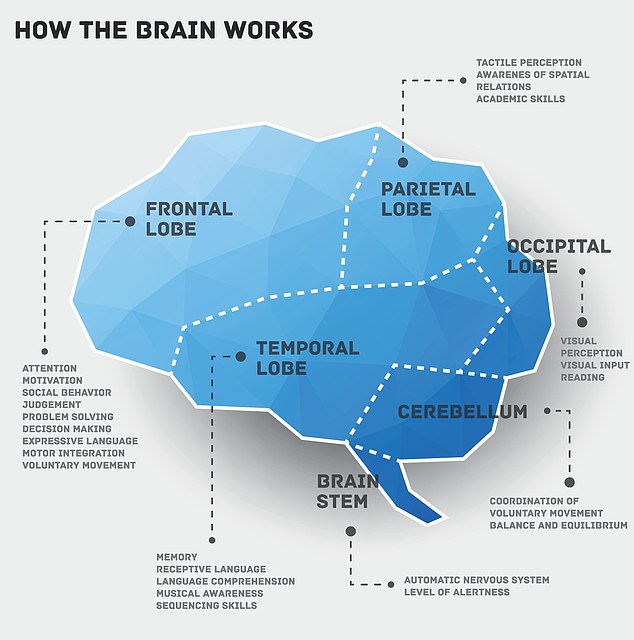What is frontotemporal dementia, which affected Wendy Williams, 59, and Bruce Willis, 68? Due to the aggressive condition, most patients require 24/7 care within five years
Wendy Williams has been diagnosed with the same aggressive and rapidly progressive form of dementia as Bruce Willis.
The talk show host, 59, announced Thursday that she has been diagnosed with frontotemporal dementia (FTD), a form of the condition that affects younger people and causes the personality and behavioral centers of the brain to shrink.
The team also confirmed that she suffers from aphasia, a symptom caused by FTD that leads to problems with speaking and understanding speech.
The diagnosis is the same as that of Die Hard star Bruce Willis, 68, and mainly affects patients under the age of 60.
About a year before Willis’ dementia diagnosis was revealed in February 2023, the family told the public that he suffered from aphasia and had difficulty speaking.
Experts say most patients end up in a nursing home within three to five years of developing frontotemporal dementia, robbed of their personality and memory.
FTD is responsible for around one in twenty cases of dementia in the US, and one in thirty in Britain.
Williams’ diagnosis comes as she and her family open up about her struggles with alcohol and abuse, as well as “cognitive issues.”
Wendy Williams was diagnosed with frontotemporal dementia and aphasia, her care team revealed Thursday; seen in February 2020 in NYC

The diagnosis is the same as that of Die Hard star Bruce Willis, 68
Dementia is an umbrella term used to describe a range of progressive neurological conditions (affecting the brain), which affect memory, thinking and behaviour.
Common symptoms include memory loss, poor judgment, confusion, repetitive questions, communication problems, taking longer to complete normal daily tasks, acting impulsively and mobility problems.
It most commonly affects older adults, with the risk increasing after age 65. According to the Alzheimer’s Association, dementia affects up to one in 10 American adults over the age of 65.
However, FTD differs from other forms of dementia, such as Alzheimer’s disease, because it usually affects adults between the ages of 40 and 60.
Dr. Susan Dickinson, the chief medical officer of the Association of Frontotemporal Degeneration, previously told DailyMail.com: ‘Think about this, you are approaching the peak of your career, you may have children at home, you are co-parenting with your partner, your husband, etc.’
“It’s not a time of life when most doctors think about dementia.”
She said this often leads to misdiagnosis, most commonly depression, bipolar disorder and Alzheimer’s disease.

95% of right-handed people and two-thirds of left-handed people use the left side of the frontal and temporal lobes of their brains to process speech. The remaining one-third of left-handed people have right-brain dominance. When there is damage to this part of the brain, speech and language suffer

Williams has previously shared her battles with the autoimmune disease Graves’ disease and lymphedema; pictured in February 2023 in NYC
But as time passes, the patient’s personality and mood change dramatically.
The Alzheimer’s Association states that “behavioral changes are often the first noticeable symptoms” of FTD, while Alzheimer’s usually causes this after the disease progresses.
“And in the meantime, the damage to someone’s relationships has been done. When it comes to family finances, for example, as I said, patients may have spent the children’s college money on a sports car or two because of errors in judgment,” Dr. Dickinson said.
“Many people lose their jobs because they make mistakes before the disease is diagnosed, which means you lose health care, perhaps for the entire family.”
“It’s really terrible, and at that younger age it has a completely different impact on a family.”
Other differences between the diseases include that FTD patients are often more apathetic, meaning they have no feelings or emotions. They may also show no concern for others or motivation.
In addition, patients may be able to remember the time of day and their location and keep track of recent events, unlike Alzheimer’s patients who have difficulty retaining new information.
But as the disease progresses, more and more parts of the brain deteriorate.
This is when symptoms become similar to those in late-stage Alzheimer’s disease, including difficulty eating or swallowing, needing help walking and being vulnerable to infections.
FTD is responsible for about one in 20 cases of dementia, affecting roughly 50,000 to 60,000 Americans.
Aphasia affects approximately one million Americans, with 180,000 diagnosed annually.
According to the Alzheimer’s Association, FTD is inherited in about a third of cases, although no other risk factors are known for the remainder of cases.
Dr. Keith Vossel, a neurologist at the University of California, Los Angeles, previously told DailyMail.com that FTD patients require full-time care within three to five years of diagnosis.
According to the Cleveland Clinic, patients can live an average of about seven years after diagnosis.
FTD in itself is not fatal, but causes other problems that are serious or even life-threatening.
These include difficulty swallowing – medically called dysphagia.
Problems with eating and drinking also increase the risk of developing pneumonia or respiratory failure.
Williams has previously opened up about other health issues, including her battles with autoimmune diseases, Graves’ disease and lymphedema.
